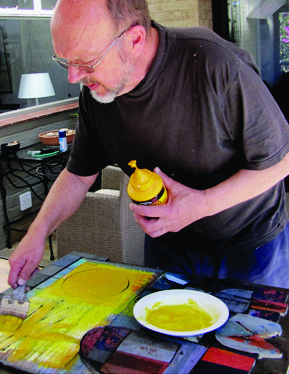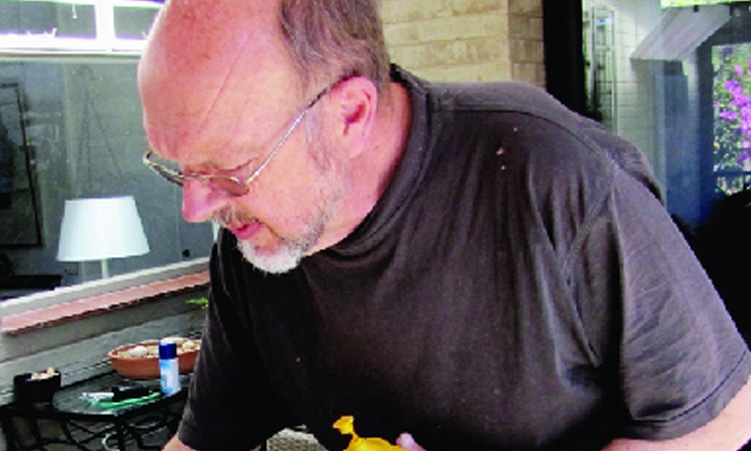Francois de Necker’s inventive brilliance flowed from his creative imagination, which had no beginning and no end.
His art encompassed many different genres – oil, watercolour, acrylics, graphics, murals of wood and metal, and free-standing sculptures of metal, wood and found objects.
His subject matter traversed abstract or semi-abstract images of landscape, interiors and figurative art.
Born at Vrede in South Africa’s Orange Free State province in 1944, Francois graduated from the Johannesburg School of Art and furthered his studies at the Visual Art Research Centre in the same city.
His art teachers included accomplished and influential artists, notably, Judith Mason, Claude van Lingen and Anna Vorster.
After working for an advertising agency in Johannesburg, he came to Windhoek in 1970 as an art teacher at Windhoek High School, where he introduced fine art as a matric subject.
In 1974 he returned to South Africa as a lecturer in the fine arts department at the University of Pretoria.
There he worked with skilful visual artists, among them the late Nico Roos, George Boys, Alexis Preller, and Bettie-Cilliers-Barnard.
In 1981 he returned to Namibia as an art lecturer at the then Teachers’ Training College in Windhoek.
Soon thereafter, he served on the committee of the Arts Association and offered private art classes to a new crop of Namibian artists, among them Joseph Madisia and Pedro Vorster.
At the beginning of 1983 De Necker joined the former Academy of Tertiary Education to establish an art department.
This ushered in a lifelong embrace with the country he came to respect and love deeply.
On his initiative, the Department of Visual Arts was established at the University of Namibia (Unam), where he was appointed as chair.
This was the start of a prodigiously productive period of many solo and group exhibitions in Namibia, South Africa, Botswana, Zambia and Western Europe.
In 1993, De Necker initiated the Centre for Visual and Performing Arts at Unam, where he served with distinction and touched the lives of many students and colleagues alike.
The following year, he was one of the co-initiators, organisers and participants in the first Tulipamwe International Artists’ Workshop in Namibia with his colleague Hercules Viljoen.
In the same year, he held a solo exhibition at the Kleine Galerie in Windhoek.
By then an established and much-loved artist, De Necker took up a Commonwealth Academic Fellowship at the De Montfort University, Leicester, in the United Kingdom.
His international participation in exhibitions included galleries in Botswana, France, South Africa, Germany, the United Kingdom and Zambia.
His work is represented, in among others, the National Art Gallery of Namibia (NAGN), the collections of Unam and of the University of Pretoria, the Levinson Collection in Cape Town, various embassies and many private and corporate collections in this country and beyond.
In 2014 De Necker was awarded a lifetime achievement award in visual arts at the Bank Windhoek Triennale.

In the Namibian art landscape, he is widely regarded as one of the pre-eminent exponents of abstract and semi-abstract art.
This set his work apart from the realistic representation of the landscape that dominated the art scene in the country for decades.
The art of abstraction is significantly more than self-referential, for it explores the music of silence, sensory life, and the presence of space and form that cannot be completely invested in paint.
There is a close nexus between the power of abstraction and the creative capacity for dedifferentiating the concreteness of a surface.
While there are many different variants of abstract art, its origin and genesis in deeply unconscious layers of the mind is beyond question.
In the work of De Necker, the landscape or fragments of the landscape became colours, both primary and secondary, metaphors, tone, symbols, values and textures surrendered by the language of harmony and organic transcendence.
The artist was a friend of paint.
He mined the sensual qualities of colour from the melancholy of “sad reds” to the vibrancy of “optimistic yellows”, to paraphrase him.
Colours and shapes sprouted from an encounter with the elemental and spiritual properties of nature, to fashion a geo-niche – geophysical allusions (metaphors) in a composition.
The textured surfaces, resulting from the skilled application of paint and sandpapering of cotton paper, enabled the artist to highlight focal points with a dash of vermillion, mauve, verdant green, orange and blue.
These colours became a signature of his work, giving it a poetic quality.
The virtuosity with which he continued to apply colour invested his paintings with an exultation of both the mind and the soul.
Reflecting upon a long and distinguished trajectory as a visual artist and educator, it becomes clear that De Necker’s way of seeing and feeling was indeed new.
Where initially he had attempted to fashion a visual language by isolating natural elements in non-specific spaces, as evident in much of his earlier work, more recently, he embraced those elements to signify more abstract concepts of energy, harmony, growth, permanence and impermanence.
Mountains and trees were no longer merely objects for evocative interpretation, but propulsion metaphors of motion, life, identity, harmony and belonging.
In some of his more recent work, he used sharply delineated colour planes that enabled him to fashion an arresting, tectonic, visual geometry.
Art became a form of ‘spiritual harmony’.
Namibia was indeed blessed to have had such a private if consummate, exponent of abstract expressionism, for whom art making was both determinate and determined.
De Necker is survived by his widow, Alida, who was also his greatest admirer, critic and friend.
- André du Pisani is emeritus professor of politics at the University of Namibia. He was a colleague and friend of the artist and opened five of his exhibitions. Du Pisani is a writer, poet, photographer, collector of Namibian and African art and a rock art researcher.
Stay informed with The Namibian – your source for credible journalism. Get in-depth reporting and opinions for
only N$85 a month. Invest in journalism, invest in democracy –
Subscribe Now!






